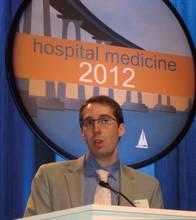SAN DIEGO – Less continuity of inpatient care by hospitalists significantly increased costs but didn’t increase readmissions in an analysis of 11,234 hospitalizations at one academic medical center.
In fact, lower continuity of care among hospitalists was associated with lower readmission rates, but this reduction was significant only in some models in the analysis, Jonathan Turner, Ph.D. and his associates reported at the annual meeting of the Society of Hospital Medicine.
The total cost of a hospitalization increased by 7% for each hospitalist that cared for the patient. For each 10% decrease in a Usual Provider of Care index, based on the largest fraction of notes written by one provider, total costs increased by 12%, said Dr. Turner, a quality and innovation engineer at Northwestern Memorial Hospital, Chicago. Neither of those parameters significantly affected the likelihood of readmission.
The study was honored by the society as one of the three best presentations at the meeting.
The large non-teaching hospitalist service works blocks of 7 days on and 7 days off at the 900-bed academic hospital, with the schedule switch and case hand-offs on Mondays. The study included only patients whose primary service was provided exclusively by hospitalists, including no ICU days. Data were collected for June 2008 to May 2011.
The investigators used the authors of progress notes to calculate the number of providers. "We’re interested in changes in the driver of care – who is directing the plan of care? When that changes, does that affect costs and readmissions?" he said.
Because hospitalist shifts changed on Mondays, subanalyses in the study compared continuity of care for admissions on Mondays vs. Tuesdays through Sundays, or on weekdays instead of weekends, or on Mondays through Wednesdays rather than Thursdays through Sundays. Results were consistent, Dr. Turner said.
Higher costs with less continuity of care may be due to changes in the plan of care by the new provider and/or additional and possibly duplicate ordering of lab tests and imaging, he speculated. Lower readmission rates in some of the analytical models might be because additional orders turned out to be beneficial to the patient, or because the change in management was beneficial.
The findings may have implications for emerging efforts to improve patient handoff design and to reduce handoffs, perhaps by modifying work schedules to increase continuity of care, he suggested.
"We don’t talk much about handoff reduction," but interest in this is increasing, he said. "There are limited things we can do to decrease length of stay. Maybe we can focus on decreasing handoffs."
Previous studies have shown that continuity in outpatient care is associated with better control of hypertension, fewer hospitalizations or emergency department visits, and higher patient satisfaction, but little is known about continuity of inpatient care. Other research found that lower continuity of inpatient care was associated with significantly increased length of stay (J. Hosp. Med. 2010;5:335-338). From 1996 to 2006, the percentage of hospitalized patients who received care from one generalist physician declined from 71% to 59% (J. Hosp. Med. 2011;6:438-444).
In the current study, an average of 1.9 hospitalists managed each hospitalization. The average Usual Provider of Care index was 0.76. The readmission rate averaged 22% and the average length of stay was 3.5 days. Hospitalists averaged 33 years in age, and patients averaged 58 years of age. The patient cohort was 46% male, 53% white, 35% black, 8% Hispanic, and 4% other races/ethnicities. Medicaid or Medicare covered 58% of hospitalizations, private insurers covered 34%, and 8% were self-pay or other situations.
The investigators plan to conduct a similar study of nursing continuity of care.
The findings were limited by data collection from a single site, and only an academic institution, and exclusion of patients with ICU stays, who are the costliest, highest-risk patients. It’s possible that the continuity metrics were not optimal, and it’s unknown if patients were readmitted to other hospitals.
Dr. Turner reported having no financial disclosures.

